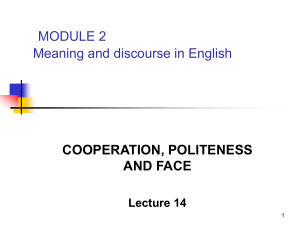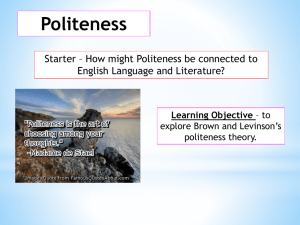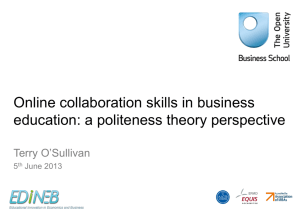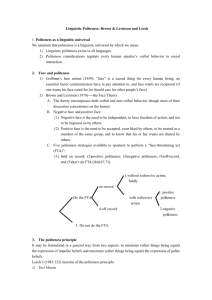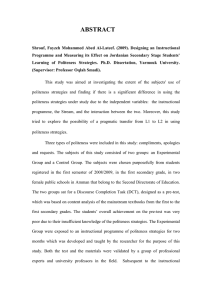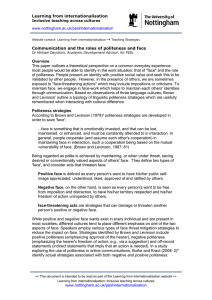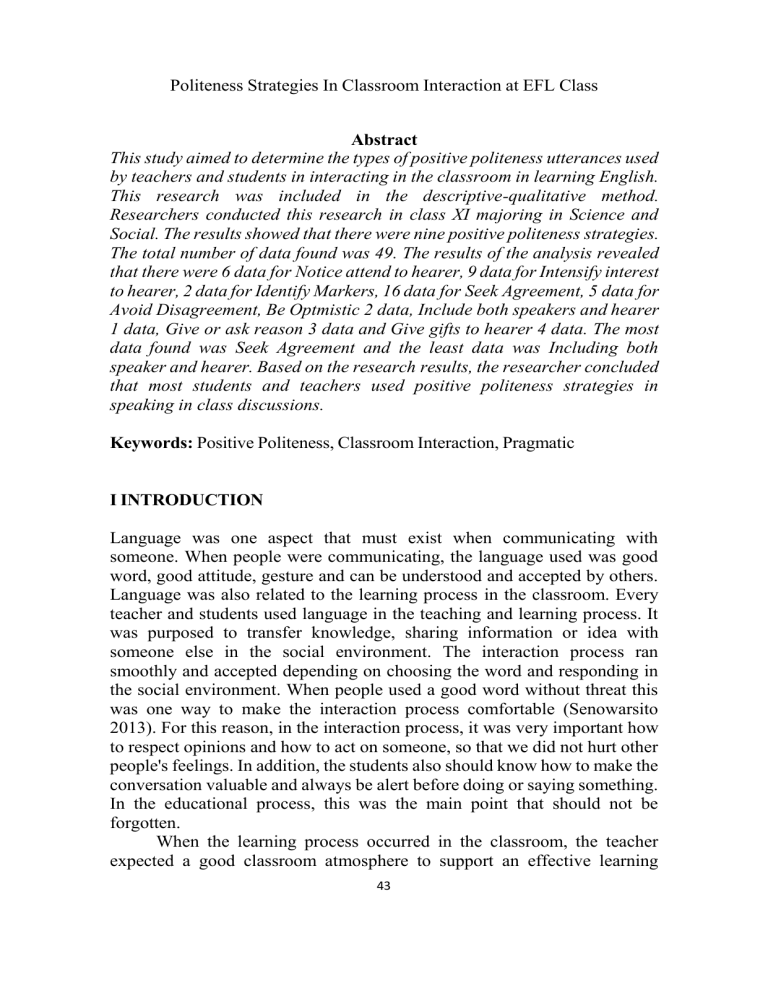
Politeness Strategies In Classroom Interaction at EFL Class Abstract This study aimed to determine the types of positive politeness utterances used by teachers and students in interacting in the classroom in learning English. This research was included in the descriptive-qualitative method. Researchers conducted this research in class XI majoring in Science and Social. The results showed that there were nine positive politeness strategies. The total number of data found was 49. The results of the analysis revealed that there were 6 data for Notice attend to hearer, 9 data for Intensify interest to hearer, 2 data for Identify Markers, 16 data for Seek Agreement, 5 data for Avoid Disagreement, Be Optmistic 2 data, Include both speakers and hearer 1 data, Give or ask reason 3 data and Give gifts to hearer 4 data. The most data found was Seek Agreement and the least data was Including both speaker and hearer. Based on the research results, the researcher concluded that most students and teachers used positive politeness strategies in speaking in class discussions. Keywords: Positive Politeness, Classroom Interaction, Pragmatic I INTRODUCTION Language was one aspect that must exist when communicating with someone. When people were communicating, the language used was good word, good attitude, gesture and can be understood and accepted by others. Language was also related to the learning process in the classroom. Every teacher and students used language in the teaching and learning process. It was purposed to transfer knowledge, sharing information or idea with someone else in the social environment. The interaction process ran smoothly and accepted depending on choosing the word and responding in the social environment. When people used a good word without threat this was one way to make the interaction process comfortable (Senowarsito 2013). For this reason, in the interaction process, it was very important how to respect opinions and how to act on someone, so that we did not hurt other people's feelings. In addition, the students also should know how to make the conversation valuable and always be alert before doing or saying something. In the educational process, this was the main point that should not be forgotten. When the learning process occurred in the classroom, the teacher expected a good classroom atmosphere to support an effective learning 43 process. In classroom interaction ideally, the student must speak politely and use good words before speaking. It also made the interaction more comfortable, harmonious and builds a positive atmosphere. One way of knowing people’s 44 Adhari, Yendra & Sesmiynati: Politeness Strategies In…(1) faces had been threatened was by their emotional reactions (Redmond, 2015). It meant in the interaction when people spoke a variety of words, people can see people's faces according to the situation. Ideally, when the interaction process occurred such as asking questions, giving comments, and commanding in the class they must pay attention to the words that was spoken so that there was no threat when speaking in the class. Furthermore, speakers must also understand the context of the situation, the time and place of when they should speak or stop to speak in class. When people spoke or utter something in class they must pay attention to these 3 aspects starting from the utterance produced by someone, the context of the situation, and facial expressions. The utterance was related to the action in a conversation. When people said something in their words, it can be related to speech acts. Hidayat (2016) stated that the speech act was how the speaker conveyed a word or sentence, not only conveying messages but also conveying someone's actions which were described in words to make the listener understand what the listener meant. In politeness, the function of speech acts was to inform and convey what students said in class with use polite words. Politeness was also closely related to pragmatic studies because pragmatics was how the language was used and also focused on meaning in context communication. According to Mariam (2017), pragmatics was concerned with those facets of meaning that were context-variable It meant that pragmatic concerned on the meaning as communicated by a speaker and interpreted by a listener or hearer in communication. So, pragmatics was related to using a language that aims to interpret meaning in people's utterances in classroom interaction. Moreover, in the class teacher and students must have the ability to make the interaction comfortable. They must be careful starting from the process of choosing words, facial expressions, and responses when interacting with someone, so that teachers did not feel threatened. Each student had different ways to communicate with friend or teacher. Students and teacher must have the qualities in communication in the class and made a good classroom atmosphere with a positive relationship in the classroom activity. It also avoided the ambiguities in the conversation between teacher and students. Teachers must be able to deal with students in the learning process. Teachers must have action to keep students from speaking politely. This was also one of the important aspects to keep the classroom environment safe and favorable. In conclusion positive politeness purpose to make classroom in class more harmonious, valuable, politely between teacher and students when doing interaction. Pragmatic was the study or branch of linguistics that focused on a 45 meaning related to a speech situation. On the other hand, pragmatism was also the study of how language was used and integrated with the meaning of context. According to Sulistyo (2008), pragmatics was the study of the relations between language and context that were basic to an account of language understanding. It meant that pragmatics was a reference for someone to gain interaction in communication, but people must see the context of the conversation. In communication, people must understand what they were talking to other people. In addition, pragmatic communication helped people’s understanding in interpreting the meaning in a language context. So that it reduced ambiguity in the communication and aimed to people that cannot be wrong in interaction. In pragmatic, it contained learning about how to interpret the utterance meaning about what people said. Pragmatic also studied about how the people or listener concluded the speaker’s intended meaning in a communication context. Conveying a message to someone was an example of a speech act in communicating. In conveying a message, someone needed to pay attention to how to convey it properly, starting from politeness, the language used, intonation, and proper pronunciation. Speakers needed to convey something with clear and precise speech acts so that the message conveyed can be well received by listeners and did not cause misunderstanding. The inappropriate use of speech act in EFL classroom may lead to 46 misunderstanding due to the distinct cultures between the origin of language and the users. It was supported by (Basra & Thoyyibah, 2017). Someone before utter something must keep speaking polite and based on context. Context was the important aspect that must exist in the pragmatic rule. Context aimed to make the people understand the topic in conversation. Contexts were embedded in the place and the environment where the language was used (Pranowo, 2020). Context aimed to make the listener understand the title in conversation. In the learning process, context was needed as a limit for someone's speech when interacting. Context played a role in understanding the meaning of language or speech in communication. Without context in a conversation, it will lead to doubts and misunderstandings when interpreting the speaker's intent. Tulgar (2016) said that context was a crucial component in understanding the meanings and intentions of other interlocutors. When talking to other people it was very important to speak based on a clear purpose or topic or also called the context of the conversation. So, context was the main point for reducing ambiguities and made the conversation can be understood by other people. The good communication occurs when people uttered something with politeness. Politeness also made a language structure and application of the right language better in social class. People needed to put politeness before interacting with other people. In addition, people with politeness made them more valued when communicating. Politeness made our impression of other people was better than not. Senowarsito (2013) stated that politeness was the use of the right word or phrase in the proper context, which was determined by the rules that were prevalent in society. Politeness was an action that regulates a person's habits in the social rules that was applied in that environment. The purpose was to create a good communication in the interaction process. With politeness, we can make interactions in the classroom more harmonious by respecting each other. In the teaching and learning process, we expected students to do FSA (face-saving action). However, if the speaker said something that might threaten the person's selfimage, it was described as a face-threatening act (FTA). To overcome this, speakers used the face-saving act (FSA) to reduce threats that may occur in the classroom during the discussion. Positive politeness strategies were politeness strategies that aimed to minimize conflict when communicating. Positive politeness was a way to hear polite utterances spoken by someone in an interaction. Positive politeness strategies were all the utterances produced by the speaker (S) which had the function to make the hearer (H) felt happy, to maintain the hearer’s positive face, and to fulfill what the hearer’s wants and needs (Nurmawati et al., 2019). The meaning of this positive politeness strategy was an effort to make the process of interaction and communication with other people safer without any threats. In addition, these positive politeness 47 strategies aimed to make what the speaker said can be accepted and followed by the wishes of the listener. In this strategy, speakers were required to maintain the positive face of the interlocutor and fulfilled the wishes and needs of the speech partner so that communication was more politely. The concept of positive politeness was saving the face of the addressee by indicating that in some respects, the speaker's wants were the hearer’s wants (Erlinda, 2019). Positive politeness was the concept used to make an FTA into an FSA. One of the goals was to make every threatening speech more acceptable or save in social interaction. This form of strategy was very useful for saving the other person's face. In other words, the concept of this strategy was used so that conversations that should not be expressed in the classroom between teachers and students were more organized and orderly so that they were accepted in the environment and make interactions more politely. Brown (1987) explained that positive politeness had 15 48 Adhari, Yendra & Sesmiynati: Politeness Strategies In…(1) strategies divided into 3 subs as claiming common ground, conveying that speaker and fulfilling hearer’s want for someone. Table 2.1 Positive Politeness Strategies in Classroom Interaction No 1 Title of strategi es Strateg y1 2 Strateg y2 3 Strateg y3 4 Strateg y4 5 Strateg y5 6 Strateg y6 7 Strateg y7 Type of Positive Politeness Meani ng This strategy means that the speaker notice the hearer in one condition. This strategy means that the Exaggerate speaker wants to protect the face of the listener, and he or she can do this by using exaggerated expressions. Intensify interest This strategy means that the speaker keeps the listener’s to Hearer positive outlook by making a good story in the conversation. Use in-group The speaker can maintain a identity positive face of the listener by markers calling his or her ingroup address list that considers different power and status from the listener Seek agreement It is used to stress emotional agreement and interest or surprise by saying the utterance that can satisfy the hearer’s desire. The utterances that used for Avoid pretending agreement or hiding disagreement disagreement in order to maintain hearer’s positive face, for instance telling white lies. Pressuppose/raise/a This can be used to show the ssert common listener what they have in ground common. In this Notice attend to Hearer 49 strategy, the speaker assumes something as if they are in the same situation. 8 Strateg y8 Jok e 9 Strateg y9 10 Strateg y 10 Assert or pressupose S’s knowledge of and concern for H’s wants Offer, promise 50 Joking is a technique for making the hearer feels relaxed and making them having enjoyment. Understanding hearer’s blessing and wants by putting hearer to cooperate with speaker. Using offers and promises to hearer in order to maintain positive face are some ways that the speaker can apply in this strategy. JULIET, September 2022; Vol(3) No (2): 43 – 55 p-ISSN 2746-0312 eISSN 2745522x Be optimistic 11 Strateg y 11 12 Strateg y 12 13 Strateg y 13 Give or ask for reasons 14 Strateg y 14 Assume or assert reciprocity 15 Strateg y 15 Include both S and H in the activity Give gifts to Hearer ( goods, sympathy, understanding, cooperation). When presenting collaborators, speakers can also use optimistic strategies. Optimism can minimize free trade agreements because the speaker thinks positively about the listener. In this strategy, there is an equal status in an activity. This is evidenced by the involvement of each other. Therefore, the speaker has appreciated and protected the positive face of the listener. The speaker of this strategy expresses cooperation with the listener by giving or asking for reasons. In communication,the speaker sometimes hopes that the listener will benefit him. This strategy refers to showing care, understanding, admiring, and listening to the hearer. Referring to previous study, the other researcher was still general in discuss about politeness strategies, because overall they were only focus about using politeness in group discussion. It was different from my research because the research focused on using a positive politeness strategy in classroom interaction during all process teaching and learning English as foreign language. It meant that the researcher sought the polite utterance in all condition during learning EFL in the classroom. The purpose of this study was to see what strategies of positive politeness used by teacher and students and how these strategies created an effective interaction. The researcher believed this strategy can promote effective interaction in the classroom. 51 II METHOD The design of this research was a qualitative research. Qualitative research was a process to collect data, analyze data, and interpret with descriptive analysis. The researcher got the data from observation with the use of the video recording of the student at XI grade in MAN 3 Padang as the respondent of the research. The subjects of this study were English teacher and students. In this qualitative study, the selected sampling was purposive simple random sampling. Purposive simple random sampling was a sampling technique that put forward the principle that all individuals had the same opportunity, for example the lottery technique. The researcher carried out the sample selection process by lottery all students at eleventh grade at MAN 3 Padang. Then the researcher found 2 classes in their school and the classes were XI IPA 1 and XI PK as a result. There was some instrument that can be used, the researcher collected the data by doing observation and then the researcher got the data by using video recorder, observation checklist, and field notes as the instrument of this research. 52 Adhari, Yendra & Sesmiynati: Politeness Strategies In…(1) The first instrument was video recording. Video recording was the instrument that shot or took a video with all activities naturally happening in the class. By using the video, the data could be immediately collected to support this thesis. Next observation checklist, an observation checklist was a list of things that an observer will see when she observed a class. The researcher used this list as an observer of the research object. Last, Field notes was a note that took about little and important things during research. The researcher analyzed the polite utterance and classify into positive politeness strategies. The researcher did observation and also made a video during teaching and learning process. Not only that the researcher also used observation checklist that related to fifteen strategies and made an important note related with researchers’ need. III RESULT Based on data analysis, the researcher found findings that teacher and students uttered by positive politeness strategies in classroom interaction as follows : Table 4.1 Positive Politeness Strategies in Classroom Interaction N o Utteranc es Type Tot al of Positi ve 1 After finish discuss about the video now answer the Politeness Notice attend to question page 34 in LKS. Please group 3 read your answer from no 1 53 Hearer 6 2 Teacher: let's see from the regent's program, you never Intensif 9 y guess usually OSIM has a program. They spoke about the program so that we could vote for him. Then they convey Interest to hearer something important to tell the reader that what he said is true. Usually, they provide reasons or arguments to support the program. It is called an analytical exposition. 3 Teacher: What is the definition kata Identify Marker benda in English is habib? 54 2 JULIET, September 2022; Vol(3) No (2): 43 – 55 p-ISSN 2746-0312 eISSN 2745522x 4 Teacher: I totally agree with you,the topic is 1 6 about cheating and the writer asks the student to stop cheating. 5 Teacher: All explanations of are your Avoid 8 disagreement almost correct, I agree with your opinion. But to be clearer, let's briefly discuss this example. Then, the subject in this example is the important document using tobe that have been followed by the object. So, we can know that this sentence is passive 6 Student: I know mamm I Be Optimistic 4 want to answer (pointing hand) 7 Teacher: Now to more video make a understand we will discuss the resume invitation, we will watch the the video about the invitation card. card and after watching the 55 about invitation Including both 1 activity speaker and hearer in 8 Teacher: “I have two cats”. Give or They are so cute. The ask for question is who are reason they? Student: Cats Teacher: Why not use I? why a cat? Student: Because I'm alone if they are many and their use is more appropriate for cats. 56 3 Adhari, Yendra & Sesmiynati: Politeness Strategies In…(1) 9 Teacher: Good job, thankyou Give gifts to 4 hearer Total 53 There were 49 main data that were analyzed and found 9 strategies of positive politeness. In this section, the analysis of research question was clearly explained. The strategies are Notice attend to hearer, Intensify interest to hearer, Identify marker, Seek agreement, Avoid disagreement, Be optimistic, Include both speaker and hearer, Give or ask for reason and Give gifts to hearer. 1. Notice attend to hearer Notice attend to hearer was the first strategies on positive politeness. It referred to the speaker notice to hearer condition. This happened when the teacher gave instructions to discuss the exercises in the workbook. For example : Teacher : After finish discuss about the video now answer the question page 34 in LKS. Please group 3 read your answer from no 1 (Recording 2 on 16th of November 2021) Based on the utterance above the researcher saw the teacher noticed the students to answer the question in the workbook. The teacher’s utterance indicated the word “Please group 3 read your answer from no 1”. Based on these utterance, the researcher can see that the participant was the teacher giving notice to the students. This was not included in the face- threatening act because the teacher had a position higher one level than the students. In addition, the reaction of students when were noticed by the teacher was that students followed her by reading the answer. This reaction was a form that the student was not threatened by the teacher's utterances (Redmon, 2015). 2. Intensify interest to the hearer Intensify to the hearer was the third strategy in positive politeness. This strategy meant that the speaker kept the listener’s positive outlook by making a good story in the conversation. It can be seen by word "you know" or "you can never guess" or using marked questions will allow the hearer to gain in the story. For example: Teacher: let's see from the regent's program, you never guess usually OSIM has a program. They spoke about the program so that we could vote for him. Then they convey something important to tell the reader that what 57 he said is true. (Recording 5 on 07th of December 2021) Based on the conversation above the teacher explained the material by telling stories to students. It can be seen in the-utterance “you never guess” that marked telling the story to their student. In that case, the teacher explained or taught the student with story-telling to their student. The teacher explained the material based on observations made previously about Osim, then the teacher used it as an example in class discussions. When an explanation or speech was based on previous observations it was called a representative in speech act (Hidayat, 2016). The explanation aimed to make the student understand to the material and teacher chose to make a story to the student. It was also the goal to make students understand and reduced doubts in the discussion process. The facet threatening act was not found because the hearer did not feel 58 JULIET, September 2022; Vol(3) No (2): 43 – 55 p-ISSN 2746-0312 eISSN 2745522x intimidated by the teacher's explanation, but the students gained knowledge and the students' faces were not threatened. When the student's reaction was normal and not threatened, it was called a face-saving act (Redmon, 2015). 3. Identify Markers Identifying markers was the fourth strategy in positive politeness. This strategy was used for people to communicate to the listener as a group member. Before speaking, it was usually used to address to other people. The speaker can maintain a positive face of the listener by calling nick name, dear, partne, sweetheart or even his or her familiar nickname For example: Teacher: What is the definition kata benda in English is habib? (Recording 4 on 30th of November 2021) The utterance above belonged to positive politeness using Identify Markers. In process discussion, the teacher randomly asked their students about the material. In the learning process, the teacher used students' nicknames to ask student about the question. Teacher called the nickname habib in the class as addressee. Based on the utterance above they used the nickname as a marker of the address to whom they were talking. When someone used address usage like a nickname when speaking it can emphasize solidarity and closeness between speakers and the hearer that can also be referred to as a face saving act (Ethelb, 2015). Therefore, the utterance was not included as a face threatening act. 4. Seek Agreement Seek Agreement was the five strategies on positive politeness. In this strategies it referred to find agreement in doing something. It can be seen when teaching learning process occurs in the class. The speaker sought agreement on a topic or material in the class. This was a strategy that allowed the speaker to find out where the hearer agrees with the speaker's opinion by making a deal. For example: Teacher: You? What is your topic? Student: Cheating has not good for student maam Teacher: For group 4 what is your topic? Student: The student should stop cheating Teacher: I totally agree with you,the topic is about cheating and the writer asks the student to stop cheating. 59 (Recording 4 on 30th of November 2021) Based on the utterance above there was a question and answer process in class between teacher and student to find agreement. It can be seen that the teacher asked questions about finding a topic in a material. The teacher and students looked for agreements related to topics that were appropriate by discussing questions related to analytical text material. We can see that students were enthusiastic in answering questions. Here, it can also be seen that the teacher cared about the opinions of students by expressing their agreement. The positive face of students will be threatened if the teacher ignored the students' opinions (Manipuspika & Sudarwati, 2017). Because the teacher cared about the students' answers and even agreed with their opinions, it was not considered a face threatening act. 5. Avoid Disagreement Avoid disagreement was the six strategies on positive politeness. In this strategies used to reject or disagree with the utterance or opinion of the hearer. The common ground of this proposition showed that the speakers showed different opinions, but it will not harm the positive outlook of the listener. These strategies had ways to avoid disagreement. 60 Adhari, Yendra & Sesmiynati: Politeness Strategies In…(1) For example: Teacher: All of your explanations are almost correct, I agree with your opinion. But to be clearer, let's briefly discuss this example. Then, the subject in this example is the important document using tobe that have been followed by the object. So, we can know that this sentence is passive. (Recording 3 on 23th of November 2021) Based on the explanation, it can be seen that the speaker tried to avoid a dispute with the hearer because of his disapproval. The act of avoiding the conflict was the speaker's way of keeping communication with the hearer from being threatened. When having a conversation and trying to make good communication to be accepted by others, it was a way to avoid FTA (Syamsir (2008). Speaker used “yes” agreement and but to avoid disagreement with the hearer. It was called token agreement where the listener used a signed agreement, meaning that the speaker preferred to say yes, but... rather than no. 6. Be Optimistic Optimistic was when the speaker can minimize free trade agreements because the speaker thought positively about the listener. In this strategies they used the expression of optimism. For example: Teacher: For question number one, who is mr rahman ? Student: I know mamm I want to answer (pointing hand) Teacher: Yes , what is your answer? Student: Writer neighbor (Recording 1 on 09th of November 2021) The situation above was when the teacher wanted to ask about exercise in the workbook. The students were spontaneous to answer the exercise. The student raised his hand as a form of confidence and immediately answered the teacher's question. We can see that from the students' utterances and reactions when the teacher asked to answer a question from the workbook. This student immediately pointed his hand and explained the answer in front of his friends without hesitation. The student was optimistic about explaining and convincing teachers and other students with his opinion. Opinion was something that someone did to express ideas or thoughts in the form of speech (Supriyanta & Ghozali, 2017). It was also responded well by the teacher to avoid FTA and the students also felt appreciated for their opinion. 7. Including both speaker and hearer Including both and speaker was an equal status in an activity. This was evidenced by the involvement of each other. In this strategy, the speaker involved the hearer in the same situation. For example: 61 Teacher: Now to more understand we will discuss the invitation, we will watch the video about the invitation card and after watching the video make a resume about the invitation card. (Recording 1 on 09th of November 2021) The conversation above occurred when the speaker involved the hearer in the same activity. The teacher invited students to watch the video as another reference to strengthen their understanding of the invitation card material. This showed that the teacher involved students in their activities and students felt that they were respected when the teacher involved them in their activities. When someone was accepted and be privy in an activity it was a form of positive politeness (Mahmud et al., 2018). When someone felt respected and appreciated in activity it was a form of face saving act or can be called freely from face threatening act. 8. Give or Ask for reason 62 JULIET, September 2022; Vol(3) No (2): 43 – 55 p-ISSN 2746-0312 eISSN 2745522x Give or ask for reason expressed cooperation with the hearer by giving or asking for reasons. This strategy usually used words such as "why not" and "how about " to ask the audience or give reasons. For example: Teacher: “I have two cats”. They are so cute. The question is who are they? Student: Cats Teacher: Why not use I? why a cat? Student: Because I'm alone if they are many and their use is more appropriate for cats. (Recording 2 on 16th on November 2021) Based on the utterance above, the situation of that conversation occurred when the teacher asks the student about using a pronoun. The teacher wanted their student critical thinking and it was marked with “Why not use I?” as a form of asking the reason for the student's answer. In the discussion, it was seen that it involved students by criticizing students in the context of seeking answer. When the teacher criticizes the students, we can see the expressions and utterances that the students expressed to the teacher. We can see the expression by emotion of someone's face (Fitriana, 2019). From the emotional and response of someone's utterance we can judge whether it is threatening or not. However, based on student responses, the researcher saw students responding politely to the teacher and there was no grumpy expression to the teacher. Based on the reaction, it was included in the face saving act. 9. Give gifts to hearer Give gifts to hearer was the fifteenth positive politeness strategy. This strategy explained the forms of appreciation, understanding and sympathy addressed to the hearer. For Example Teacher: Good job, thankyou (Recording 1 on 09th of November 2021) Based on the data above, the situation when the student answered the question from the teacher and wrote the answer in front of the class. After the student finished writing in front of the class the teacher gave appreciation with the student. Beside that the teacher gave appreciation with saying good job as a form of positive impression for their efforts to answer questions in front of the class. It built a class atmosphere that had a good spirit. In classroom interaction, it was necessary to maintain politeness in to keep harmonious class in avoiding face threatening acts to person ((Senowarsito (2013)). When the class became harmonious it created a comfortable 63 classroom environment and the teaching and learning process ran smoothly. IV. DISCUSSION There were findings of positive politeness strategy, the researcher found 9 strategy of positive politeness. They were Notice attend to hearer 6 data, Intensify interest to hearer 9 data, Identify to hearer 2 data, Seek agreement 16 data, Avoid disagreement 5 data, Be optimistic 2 data, Include both speaker and hearer 1 data, Give or ask for reason 3 data and Give gifts to hearer 4 data. Seek agreement was mostly used and Include both speaker and hearer was least used in the classroom. Brown Levinson (1987) said that Positive politeness was compensation aimed at the recipient's positive face to satisfy desires by avoiding threats to each other. Through positive politeness, this was a strategy to avoid threats when learning in class. This was useful for increasing effectiveness in the class discussion process. This strategy was telling experience to the hearer about communication that occurred spontaneous without planning before. 64 Adhari, Yendra & Sesmiynati: Politeness Strategies In…(1) V. CONCLUSION Based on the findings above, the researcher hoped that teacher still maintained using politeness in teaching and learning process. The researcher hoped the polite language can keep be used when speaking with other people in the classroom. For all students, the researcher suggested that to use polite language and improve to be more politely to maintain harmonious with each other. The student must politely when speaking with other people even in school or other place. I found one quote that was treat everyone with politeness, even those who are rude to you not because they are nice but because you are. REFERENCES Basra, S. M., & Thoyyibah, L. (2017). A speech act analysis of teacher talk in an efl classroom. 10(1), 73–81. Brown, P. (1987). Politeness: Some Universals in Language Usage. STUF Language Typology and Universals, 42(1), 135–135. https://doi.org/10.1515/stuf-1989-0124 Erlinda, R. (2019). Positive Politeness Strategies in EFL Classroom Interaction. https://doi.org/10.31227/osf.io/n69ps Ethelb, H. (2015). Using Address Terms in showing Politeness with Reference to Their Translation from Arabic into English. International Journal of Comparative Literature and Translation Studies, 3(3). https://doi.org/10.7575/aiac.ijclts.v.3n.3p.27 Fitriana, A. (2019). Jurnal Pendidikan Bahasa dan Sastra Indonesia. Jurnal Pendidikan Bahasa Dan Sastra Indonesia, 8(1), 104–115. https://journal.unnes.ac.id/sju/index.php/jpbsi/article/view/24018 Hidayat, A. (2016). Speech Act: Force Behind Words. Jurnal Tadris Bahasa Inggris, 9(1)(1), 1– 12. Mahmud, M., Subar, W., & Sukardiweda. (2018). Politeness Strategies Used By Efl Teacher. 1994. Manipuspika, Y. S., & Sudarwati, E. (2017). Politeness strategies in text messaging (A case study of students’ text messages to the lecturers in English study program Universitas Brawijaya). MALTESAS MultiDisciplinary …, 2(May), 1–13. https://maltesas.my/msys/explore/docs/2017/12_1494394219.pdf Mariam, F. dkk. (2017). Pragmatics and Discourse Analysis. Introducing 65 Linguistics, August, 356–375. https://doi.org/10.1017/9781108696784.011 Muhammad Syamsir. (2008). Politeness strategies used by the community in daily conversation. Journal of Food System Research, 15(2), 44–50. https://doi.org/10.5874/jfsr.15.2_44 Nurmawati, N., Atmowardoyo, H., & Weda, S. (2019). An Analysis of Positive Politeness Strategies to Promote Effective Interaction in The Classroom. ELS Journal on Interdisciplinary Studies in Humanities, 2(2), 171–181. https://doi.org/10.34050/els- jish.v2i2.6340 Pranowo, P. (2020). the Role of Context in the Interpretation of Pragmatic Meaning. RETORIKA: Jurnal Bahasa, Sastra, Dan Pengajarannya, 13(2), 256–267. https://doi.org/10.26858/retorika.v13i2.12666 Redmond, M. . (2015). Face and Politeness. Encyclopedia of Health Communication. https://doi.org/10.4135/9781483346427.n183 66 JULIET, September 2022; Vol(3) No (2): 43 – 55 p-ISSN 2746-0312 eISSN 2745522x Senowarsito, & Timur, S. (2013). Politeness Strategies in Teacher-Student Interaction in an Efl Classroom Context. TEFLIN Journal: A Publication on the Teaching and Learning of English, 24(1), 82–96. https://doi.org/10.15639/teflinjournal.v24i1/82-96 Sulistyo, E. T. (2008). Pragmatik Suatu Kajian Awal. Ilmu Dasar Pragmatic. Supriyanta, & Ghozali, I. (2017). an Analysis of Politeness Strategies Used By Claire Peterson in the Boy Next Door Movie. Journal of English Language and Language Teaching, 1(1). Takkaç Tulgar, A. (2016). The Role of Pragmatic Competence in Foreign Language Education. Turkish Online Journal of English Language Teaching, 1(1), 10–19. https://doi.org/10.32959/tojelt.229304 Umayah, S., Putra, I. N. A. J., & Suprianti, G. A. P. (2018). Politeness strategies in teacher- students classroom interaction at the eleventh grade students of SMK PGRI 1 Singaraja. Jurnal Pendidikan Bahasa Inggris Undiksha, 4(2). Herreid, C. F. 1994. Case studies in science—a novel method of science education. J. Col. Sci. Teach. 23(4):221–229. Jones, D. G., & Monieson, D. D. (2015). The origin and early development of the case method in MARKETING PEDAGOGY. Proceedings of the 1988 Academy of Marketing Science (AMS) Annual Conference, 156– 160. https://doi.org/10.1007/978-3-319-17046-6_31 Kunselman, J.C., Johnson, K.A., 2004. Using the case method to facilitate learning. College Teaching 52 (3), 87–92. KEMDIKBUD. (2020). Buku Panduan Indikator Kinerja Utama Perguruan Tinggi Negeri. McLean S. F. (2016). Case-Based Learning and its Application in Medical and Health-Care Fields: A Review of Worldwide Literature. Journal of medical education and curricular development, 3, JMECD.S20377. https://doi.org/10.4137/JMECD.S20377 Mostert, M. P. (2007). Challenges of case-based teaching. The Behavior Analyst Today, 8(4), 434–442. Roell, C. (2019). Using a Case Study in the EFL Classroom. ERIC. https://doi.org/EJ1236098 Schmidt H. G. (2000). Assumptions underlying self-directed learning may be false. Medical education, 34(4), 243–245. https://doi.org/10.1046/j.13652923.2000.0656a.x Thistlethwaite, J. E., Davies, D., Ekeocha, S., Kidd, J. M., MacDougall, C., Matthews, P., Purkis, J., & Clay, D. (2012). The effectiveness of Case-based learning in health professional EDUCATION. A beme systematic REVIEW: BEME GUIDE No. 23. Medical Teacher, 34(6). https://doi.org/10.3109/0142159x.2012.680939 Williams B. (2005). Case based learning--a review of the literature: is there scope for this educational paradigm in prehospital education?. Emergency medicine journal : EMJ, 22(8), 577–581. https://doi.org/10.1136/emj.2004.022707 55
